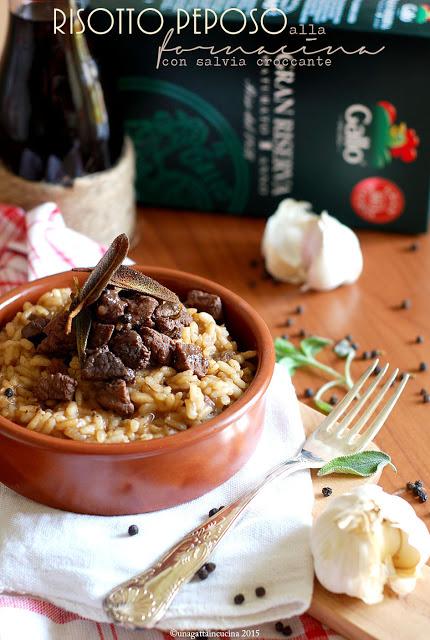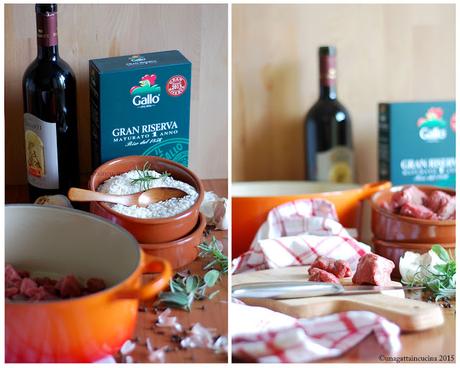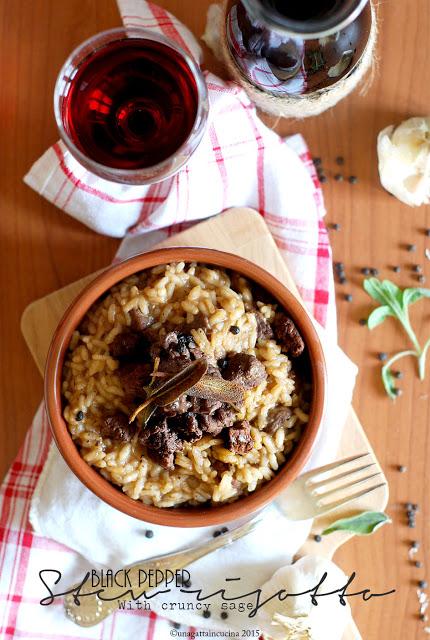
Quando mi è stato chiesto di ideare un risotto che rappresentasse al meglio la cucina della mia regione d'origine, ovvero la Toscana, ho pensato a lungo, ho preso appunti e scritto tutto quello che mi veniva in mente in termini di caratteristiche, ingredienti, piatti tipici in un flusso continuo di idee...
Ingredienti genuini e essenziali, cotture lunghe, sapori robusti, spezie ed erbe aromatiche, forte attaccamento alla terra, bottiglia di Chianti... trippa alla fiorentina, lampredotto, zuppa di farro, minestra di pane, panzanella...
Potrei andare ancora avanti, ma mi fermo dicendovi: Peposo. Uno dei piatti più famosi della cultura toscana, nata sulle colline fiorentine dell'Impruneta, ai tempi del Brunelleschi.
Il nome "alla fornacina", si dice, sia ispirato dagli "inventori" di questo piatto, ovvero gli addetti alla cottura dei mattoni, che stufavano a lungo la carne con il vino all'imboccatura dei forni.
E' un piatto povero di ingredienti (non c'è, anche nella ricetta originale nessun tipo di olio né bisogno di soffritto), ma ricco di profumi e sapori.
Io ho scelto di usare la carne chianina, perché mio padre è nato in Val di Chiana e quindi è un territorio a cui sono legata. Come sapere mangio pochissima carne, ma quando lo faccio dev'essere di qualità.
Il vino, non poteva che essere, per le stesse ragioni, un Chianti. Avrei usato il mio, ma sarei dovuta tornare a Firenze a rifornirmi di qualche bottiglia! (Ma lo farò presto).
Infine, il "tocco in più" è dato dalla salvia fritta, anche qui un omaggio alla cucina contadina, ma io, a differenza di mia nonna, ho semplicemente impanato le foglioline con la farina di ceci, senza pastella e tuffate per pochi secondi nell'olio d'oliva, che in questo caso,è quello del mio oliveto di famiglia.
E così ho unito il peposo, che di solito si accompagna a spesse fette di pane toscano, al Riso Gallo Gran Riserva, che è perfetto per questo piatto corposo e di carattere.
La ricetta è in sfida, ironia della sorte, con la regione che mi ha adottata ormai 7 anni, il Piemonte.
Cliccando -> questo link potete votarmi!!

Ingredienti:
200 g di riso gallo Gran Riserva
500 gr di muscolo di chianina
1 cucchiaio di pepe nero di grani
1 cucchiaio di concentrato di pomodoro
500 ml di vino rosso Chianti + 2 bicchieri per il riso
Brodo q.b.
3 spicchi di aglio
Salvia e rosmarino
Sale
Per la salvia fritta:
6 foglie di salvia
Farina di ceci
Olio e.v.o.

Come si fa:
Mettete il muscolo tagliato a cubetti in una casseruola capiente e fate rosolare da tutti i lati.
Unite poi gli spicchi d’aglio, il pepe nero e gli odori (potete racchiuderli dentro una garza per far si che non si disperdano in cottura. Io come vedete ho scelto di metterli direttamente nella casseruola).
Coprite con il mezzo litro di vino e fate cuocere a fiamma bassa per almeno 1 ora e mezza.
Aggiustate di sale, aggiungete circa 200 ml di acqua e proseguite la cottura fino a che la carne è morbida e si sarà formato un cremoso fondo si cottura.

Togliete la carne, sistemandola in un'altra pentola con il coperchio per tenerla in caldo.
Nella stessa casseruola dove ha cotto il peposo fate tostare il riso, sfumate con il vino e portate avanti la cottura con il brodo caldo.Per la salvia fritta: salate e asciugate le foglie, passatele nella farina di ceci e friggetele pochi secondi in una padella con l'olio d'oliva ben caldo.
Servite il riso con qualche cucchiaiata di peposo e le foglioline di salvia fritta.
{ english }

When Riso Gallo asked me to make a risotto that represents the kitchen of my home region, Tuscany, I thought for long and hard, I took notes and wrote everything I could think of in terms of distinctive features, ingredients, typical recipes in a continuous flow of ideas ...Genuine and essential ingredients, long cooking, robust flavors, spices and herbs, strong attachment to the homeland, bottle of Chianti ... Florentine tripe, barley and vegetables soup, bread soup, panzanella ...I could go on, but I will stop on: Peposo. One of the most famous dishes of Tuscan culture, born in the Florentine hills of Impruneta, at the time of Brunelleschi.The otiginal name "fornacina", is inspired by the "inventors" of this dish, or those involved in the firing of the bricks, which stew meat for long time with red wine at the furnace mouth.It ' s a simple dish with few ingredients (there is not even in the original recipe of any oil or need fried), but rich in aromas and flavors.I chose to use the Chianina meat, because my father was born in Val di Chiana, and so it is a territory that I love so much. As you know, I eat meat rarely, but when I do must be of quality.The wine, which could not be, for the same reasons, a Chianti. I'd wanted to use my wine, but I would have to return to Florence to stock up on a few bottles! (But I will soon).Finally, the "extra touch" is given by the fried sage, again a tribute to my country and family cooking, but I, unlike my grandmother, simply breaded leaflets with chickpea flour, without batter and dipped for a few seconds in olive oil, in this case, I used oil from my olive grove.And so I joined the peposo, that usually is accompanied by thick slices of Tuscan bread, with Riso Gallo Gran Riserva, which is perfect for this dish and full-bodied character.

ingredients:
200 g of rice rooster Gran Riserva500 g of beef muscle (Chianina, for me)1 tablespoon black pepper grains1 tablespoon tomato paste500 ml of red wine Chianti + 2 glasses for the riceBroth q.s.3 garlic clovesSage and rosemarysalt
For the fried sage:6 sage leavesChickpea flourOil e.v.o.
Directions:Put the diced muscle in a large pot and brown on all sides.Then add the garlic, black pepper and smells (you can enclose them in cheesecloth to make that are not dispersed in cooking. I see how I chose to put them directly into the saucepan).Cover with half a liter of wine and cook over low heat for at least one hour and a half.Season with salt, add about 200 ml of water and cook until the meat is soft and has formed a creamy background is cooking.
Remove the meat, arranging it in another pot with a lid to keep warm.In the same pan where baked peposo toast the rice, add the wine and carried on cooking with the hot stock.
For the fried sage: salted and dried leaves, roll them in chickpea flour and fry a few seconds in a pan with olive oil hot.Serve the rice with a few tablespoons of peposo and fried sage leaves.







